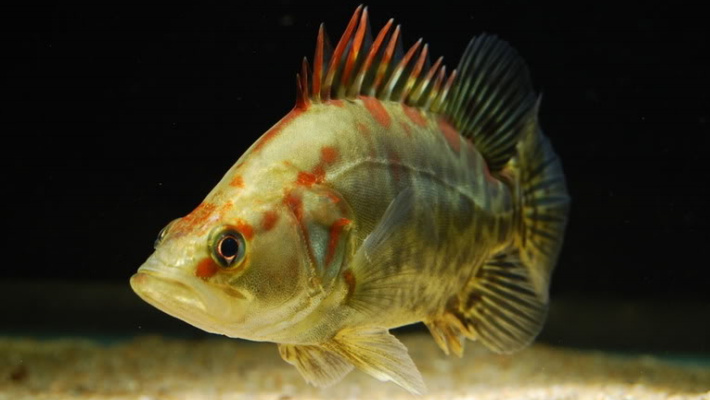|
Blue Fox
company offers spinning lures with lots of spotted blades under the mark Vibrax Hot Pepper.
Other
producers of spinning lures use the same or similar design patterns. For decades, these patterns are considered as classic: the effectiveness of them is taken for granted, not qualified or verified. However, direct
comparisons in the field of spinning lures with spotted blades and plain blades
do not confirm clearly this banality. An objective of tests described below was to compare these lures using schooling perch, Perca fluviatilis, in the capacity of test objects.
Spinning
lures of two types, Vibrax Hot Pepper #1 with black-yellow
ring spots on silver blades (SYB) and silver Vibrax Original without spots (S), were compared in the
field. At each estimated locality of perch, 20 presentations (cast and retrieving) of lures were made: 5
with SYB, 5 with S, 5 with SYB and 5 with S. Then an experimentator moved to the
other locality, where 20 presentations of the compared lures were made in the
reverse order. In total, 220 lure presentatations per 1 day were made, 43 perch
were included in the calculation (see Table, null and equal results for SYB and S lures were canceled).
For
comparison, the number of landed perch were group per each 10 lure presentations (180 lure presentations were included in the calculation).
Vibrax Original #1
silver blade without spots
| Vibrax Hot Pepper #1
silver blade with black spots
| 2
| 3
| 1
| 3
| 3
| 2
| 4
| 3
| 1
| 2
| 3
| 4
| 1
| 3
| 2
| 1
| 2
| 3
|
Total number of landed perch
19
| Total number of landed perch
24
|
Mean number
per 10 lure presentations
2,11
| Mean number
per 10 lure presentations
2,67
|
Lures had the same brass cores with slver bells
Perch were released. Some landed and released Northern pike, Esox lucius, were no included in the calculation.
At the first
glance, it seems that lures with spotted blades are slightly more
effective (on an average, 2,67 perch per 10 lure presentations) than lures
with plain blades (2,11 perch). However, an estimation of mean difference
with the assistance of Student’s t-test
does not confirm this hypothesis (n1 = 9, n2 = 9, k =16, tfact
< tstandard): perch show preference for neither of lures.
The same
results were obtained within several sessions. However, in some other sessions,
perch displayed the preference for lures with spotted blades
(Student’s t-test, p <0.05).
There are
at least two ways to explain these ambiguous results.
Looking in
the water at the lure with black-yellow ring spots on the silver background, you will see with increasing the velocity of its movement
and, in turn, the velocity of blade rotation the following picture. First you
will see flashing black (eyellowish) spots, then the spots will merge into the
dark circles, then the dark circles will merge into the colorless
(semi)transparent aureole. For example, click here to see how Mepps spinners move (at the constant velocity) in the water.
According
to the laboratory experiments (Gehres & Neumeyer, 2007; Stojcev et al., 2011), fish (goldfish, Carassius auratus) see as colored only slow-moving (2-4 cm per second) red and blue discs.
The so
called critical frequency of flash fusion (CFFF) in Northern pike, E. lucius, (28 flashes per second) and
human (18-24 flashes per second) are sufficiently close (Protasov, 1978). In
adult roach, Rutilus rutilus, CFFF is
essentially less (16 flashes per second) (Sbikin, 1980). According to the same
author, in perch, P. fluviatilis,
CFFF is higher (33 flashes per second). It means (reviwed by Protasov, 1978;
Sbikin 1980) that prech are able to discriminate flashing of visual objects at the
higher velocity than human, pike, E.
lucius, roach, R. rutilus, and other
fish.
In our case,
perch can see the spots as flashing objects or objects fused together (into circles or an
aureole), because the velocity of lure retrieving is not fixed in
practice.
Note also
that perch are chiefly overtake-and-catch predators (like yellow perch, P. flavescens: Nursall, 1973). Perch that pursue the lures cannot see any details in their front coloration. In our case, the number of these perch is unknown.
Basic References
Gehres
M.M., Neumeyer C. 2007. Small field motion detection in goldfish is red-green
color blind and mediated by the M-cone type.
Visual Neuroscience 24, 399-407 Nursall J.R. 1973. Some behavioral interections between spottail shiners (Notropis hudsonius), yellow perch (Perca flavescens), and Northern pike (Esox lucius). Journal of the Fisheries Research Board of Canada 30, 1161-1178
Protasov
V.R. 1978. Fish behaviour. Mechanisms of fish orientation and their use in
fishing. Food
Industry, Moscow
Sbikin Y.N.
1980. Age changes in vision of fish in connects with the peculiarites of their
behaviour. Nauka, Moscow
Stojcev M.,
Radtke N., D'Amaro D., Dyer A.G., Neumeyer C. 2011. General principles in motion
vision: Color blindness of object motion
depends on pattern velocity in honeybee and goldfish. Visual Neuroscience 28, 361-370
| 







 SUBSCRIBE
SUBSCRIBE


